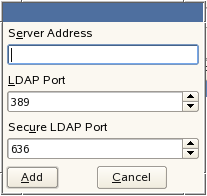5.4 Upgrading to OES 2015 SP1
Use the following instructions to complete the upgrade applicable to the installation source you are using:
5.4.1 For Servers with EVMS and LVM on the System Device
If you are attempting to upgrade an OES 2 SP3 server that has boot and swap partitions controlled by EVMS, to OES 2015 SP1, you must manually perform the following steps before the system reboots in order to restore the boot and swap disks to the default /dev/system/sys_lx directory.
Do the following before the system reboots:
-
Update the /etc/fstab file by removing /evms/lvm2 from the swap and root partitions, then modify the /dev/evms/ path for /boot to /dev.
-
Remove the /evms/lvm2 path from the /boot/grub/menu.lst file. Optionally, verify that the /etc/sysconfig/bootloader file has the correct entry for the boot device.
5.4.2 Using Physical Media to Upgrade
-
Ensure that the server meets the upgrade requirements. See Meeting the Upgrade Requirements.
-
Insert the OES 2015 SP1 Integrated DVD into the DVD drive of the server that you are upgrading to OES 2015 SP1, then reboot the machine.
-
From the DVD boot menu, specify the following based on your current OES server version.
-
For upgrades from OES 2, OES 11 SP2, OES 11 SP3, or OES 2015 to OES 2015 SP1: Select the Installation option that best fits your environment, then press Enter.
-
-
Select the language that you want to use, agree to the license terms, then click Next.
-
On the License Agreement page, click Yes, I Agree to the License Agreement > Next.
-
Follow the prompts, using the information contained in the following sections:
-
Verify that the upgrade was successful. See the procedures in Verifying That the Installation Was Successful.
-
Complete the server setup by following the procedures in Completing OES Installation or Upgrade Tasks.
5.4.3 Selecting the Installation Mode Options
-
When the Installation Mode page displays, select the following menu options:
-
Update an Existing System
-
Include Add-On Products from Separate Media
IMPORTANT:To upgrade previously installed OES services and install any additional OES services, you must select the Include Add-On Products from Separate Media option. If you don’t, only SLES is updated (if necessary). None of the OES services are upgraded. This selection is not required if you are using the integrated ISO.
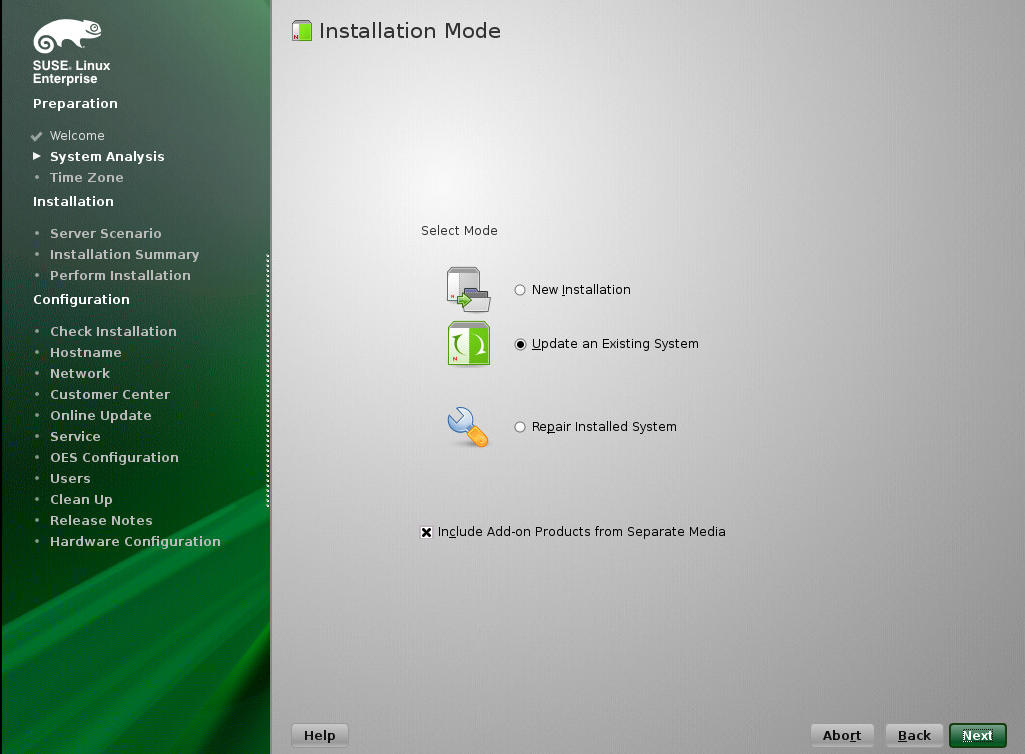
-
-
Click Next.
-
Continue with Specifying the Partition to Update or Specifying the Add-On Product Installation Information, depending on which matches your installation.
5.4.4 Specifying the Partition to Update
YaST tries to determine the correct root (/) partition. If there are several possibilities, or if YaST can’t definitely determine the correct root partition, the Select for Update page displays.
-
If there is only one partition listed, click Next.
-
If there are several partitions, select the partition with /lvm in the path.
-
Click Next.
YaST reads the old fstab on this partition to analyze and mount the file systems listed there.
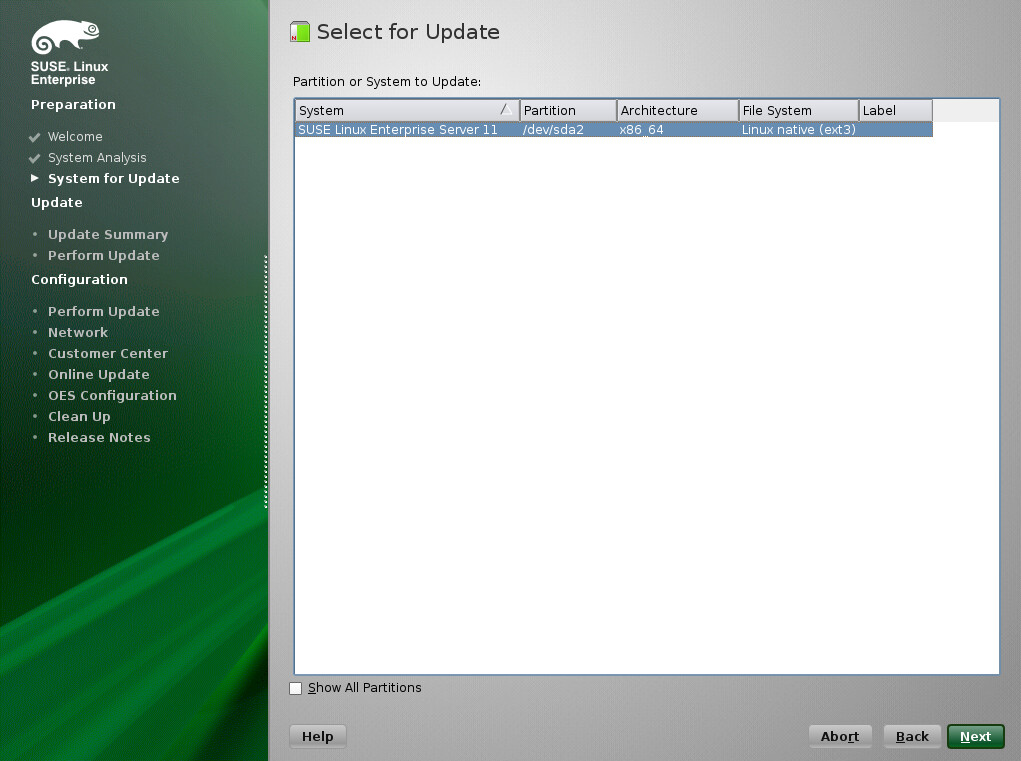
Next, YaST tries to mount the boot (/boot) partition.
-
Continue with Specifying the Add-On Product Installation Information.
5.4.5 Specifying the Add-On Product Installation Information
-
When the Add-On Product Installation page displays, click Add.
-
In the Add-On Product Media page, if you are installing from physical media, click DVD > Next. Otherwise, skip to Step 3.
-
In the Insert the Add-On Product DVD dialog box, select the drive where you want to insert the DVD labeled Novell Open Enterprise Server 2015 SP1 DVD if there is more than one drive.
-
Click Eject.
-
Insert the DVD labeled Novell Open Enterprise Server 2015 SP1 DVD, click Continue, then skip to Step 4.
-
-
If you are using an alternate installation source (such as a network location), click the appropriate option (such as the network protocol that matches your installation source), then click Next and specify the information for the source you have specified.
-
Read and accept the Novell Open Enterprise Server 2015 SP1 license agreement, then click Next.
-
Confirm that the Add-On Product Installation page shows the correct path to the OES media, then click Next.
5.4.6 Verifying and Customizing the Update Options in Installation Settings
IMPORTANT:To verify that previously installed services are selected for installation and to install any additional OES services during the upgrade, you must customize the Update Options on the Installation Settings page.
To verify or customize the software packages that are installed on the server:
-
If Novell Open Enterprise Server is not listed, click the Add-On Products link and follow the steps in Specifying the Add-On Product Installation Information.
-
On the Installation Settings page, click Update Options.
-
In the Update Options page, click Update with Installation of New Software and Features Based on the Selection > Select Patterns.
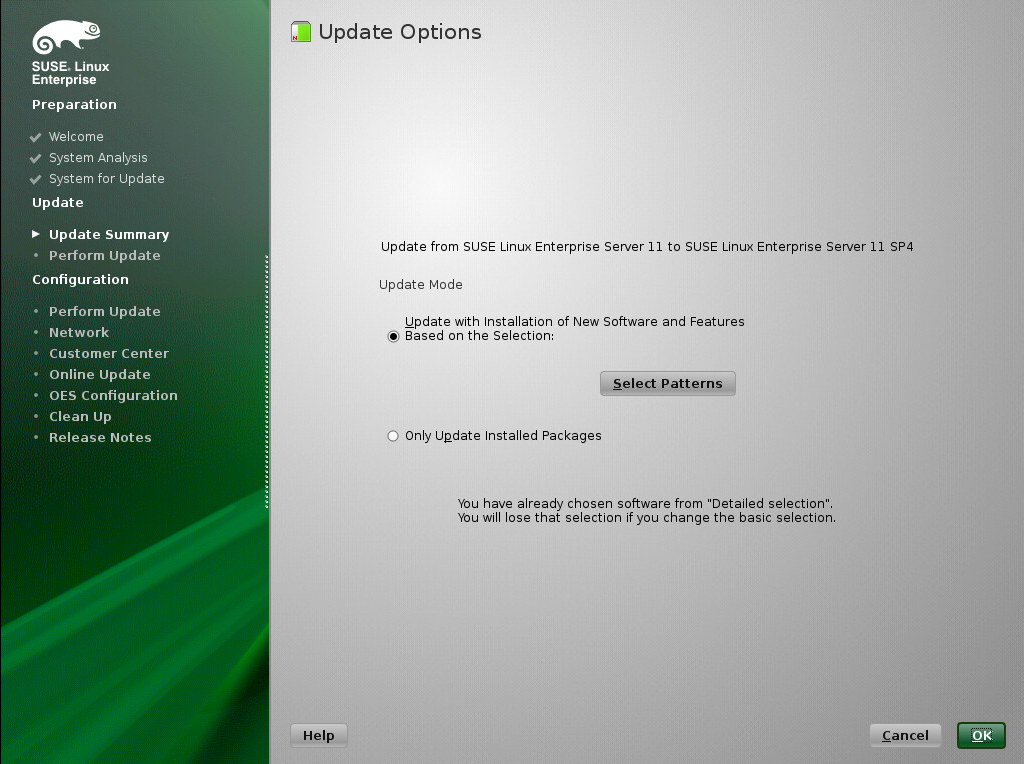
-
All of the OES Services patterns that were previously installed are selected by default.
Ensure that the patterns for the services you are upgrading are selected, then select the patterns for any new OES Services patterns that you might want to also install.
A description displays to the right of a pattern when the pattern is selected. For a description of OES Services patterns and the components selected with each pattern, see Table 2-5.
Some OES services, such as Novell CIFS and Novell Samba, are not supported together on the same server. For more information, see
Unsupported Service Combinations
in the OES 2015 SP1: Planning and Implementation Guide.IMPORTANT:If you deselect a pattern after selecting it, you are instructing the installation program to not install that pattern and all of its dependent patterns. Rather than deselecting a pattern, click Cancel to cancel your software selections, then click the Select Patterns heading again to choose your selections again.
Selecting only the patterns that you want to install ensures that the patterns and their dependent patterns and packages are installed.
If you click Accept and then return to software pattern selection page, the selections that you made become your base selections and must be deselected if you want to remove them from the installation proposal.
Attempting to uninstall a service by deselecting its pattern is not recommended. For more information, see Section 14.0, Disabling OES 2015 Services.
Selecting a pattern automatically selects the other patterns that it depends on to complete the installation.
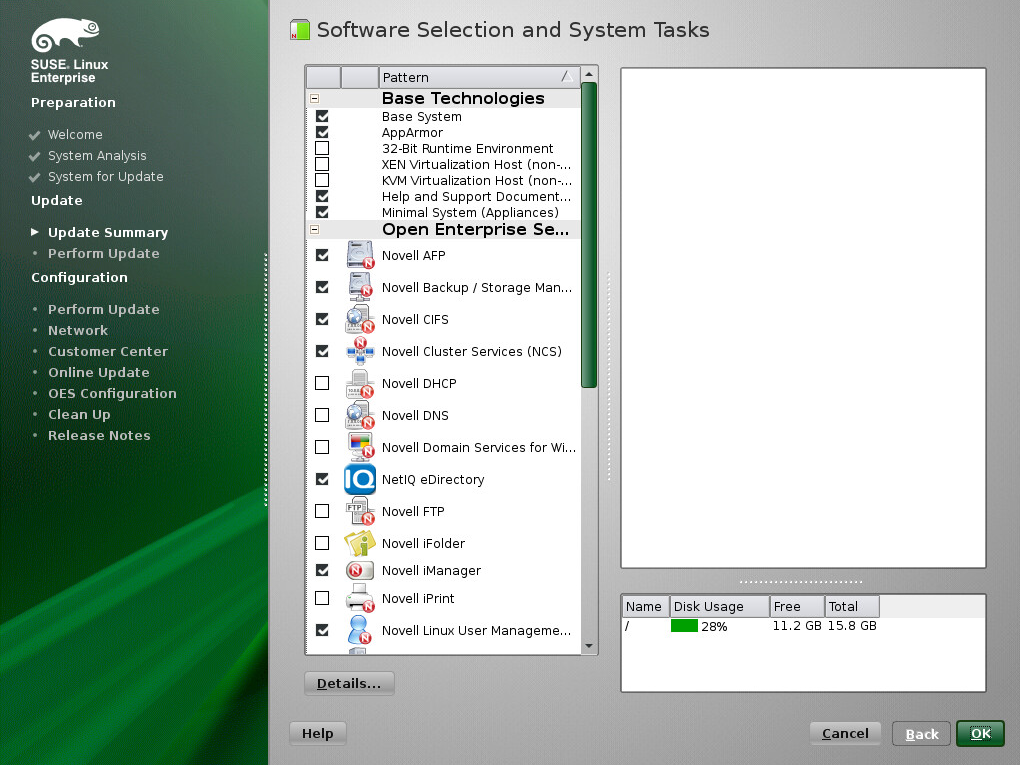
-
If you want to see the details of your selections, click Details....
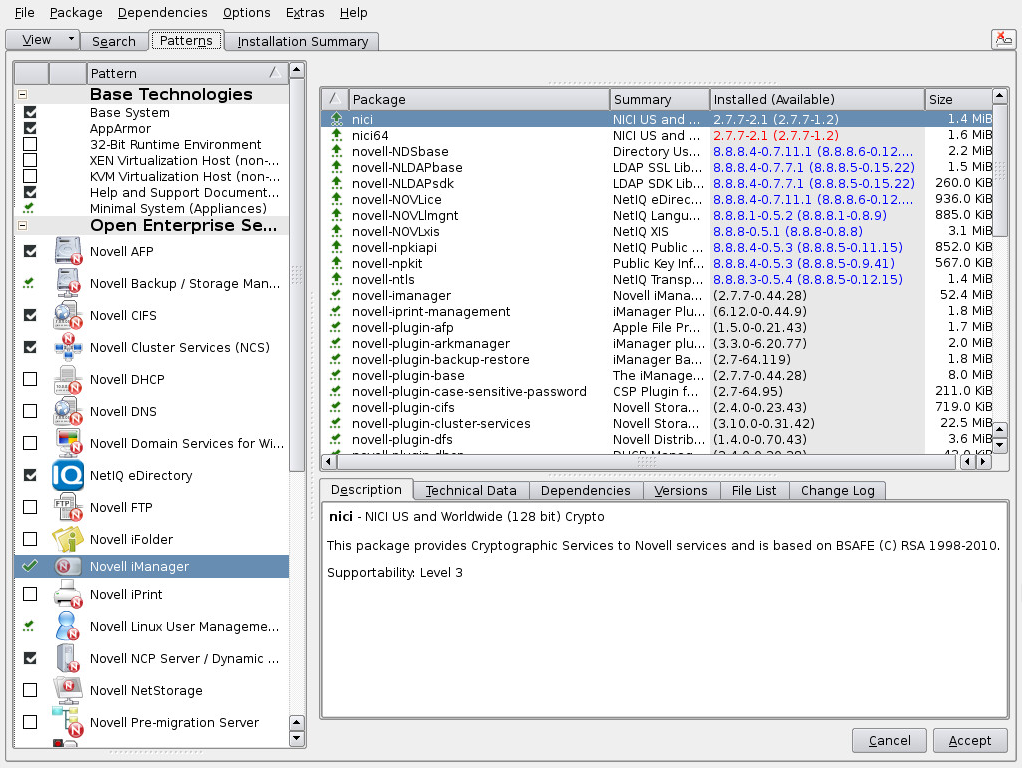
NOTE:The RPMs listed here are not selected automatically during an upgrade to OES 2015 SP1. They must be manually selected under the following upgrade scenarios:
-
When upgrading to OES 2015 SP1 from OES 2 SP3, ensure that you select the novell-ndsgrepair RPM under the eDirectory pattern. This RPM was added to OES beginning with OES 11 SP1.
-
When upgrading to OES 2015 SP1, ensure that the following RPMs present: eDirectory (novell-edirectory-log4cxx, novell-edirectory-xdaslog, novell-edirectory-xdaslog-conf, and novell-edirectory-xdasinstrument), and iManager (novell-plugin-instrumentation). These RPMs were added to OES beginning with OES 11 SP2. The novell-plugin-instrumentation RPM is required only on servers that have iManager installed. If you attempt to install this RPM with zypper in novell-plugin-instrumentation on a server that does not have iManager installed, zypper will install iManager automatically due to the dependencies. This will result in iManager getting installed on all server.
-
-
When you have the software components selected that you want to install, click Accept.
-
When the notification about deleting unmaintained packages appears, click OK.
-
(Conditional) If the prompt for the AGFA Fonts license displays, read the agreement, then click Accept.
-
(Conditional) If the prompt for Automatic Changes displays, click Continue.
-
(Conditional) If you are prompted to resolve any dependency conflicts, resolve them.
-
If the Update Options page displays again, click OK.
-
On the Installation Settings page, ensure the following id listed under the Update Options:
-
Update to SUSE Linux Enterprise Server 11 SP4
-
Update to Novell Open Enterprise Server 2015 SP1
NOTE:This page should not display Update to SUSE_Service Pack 4 Migration Product under Update Options.
If they are true, proceed with Section 5.4.7, Accepting the Installation Settings.
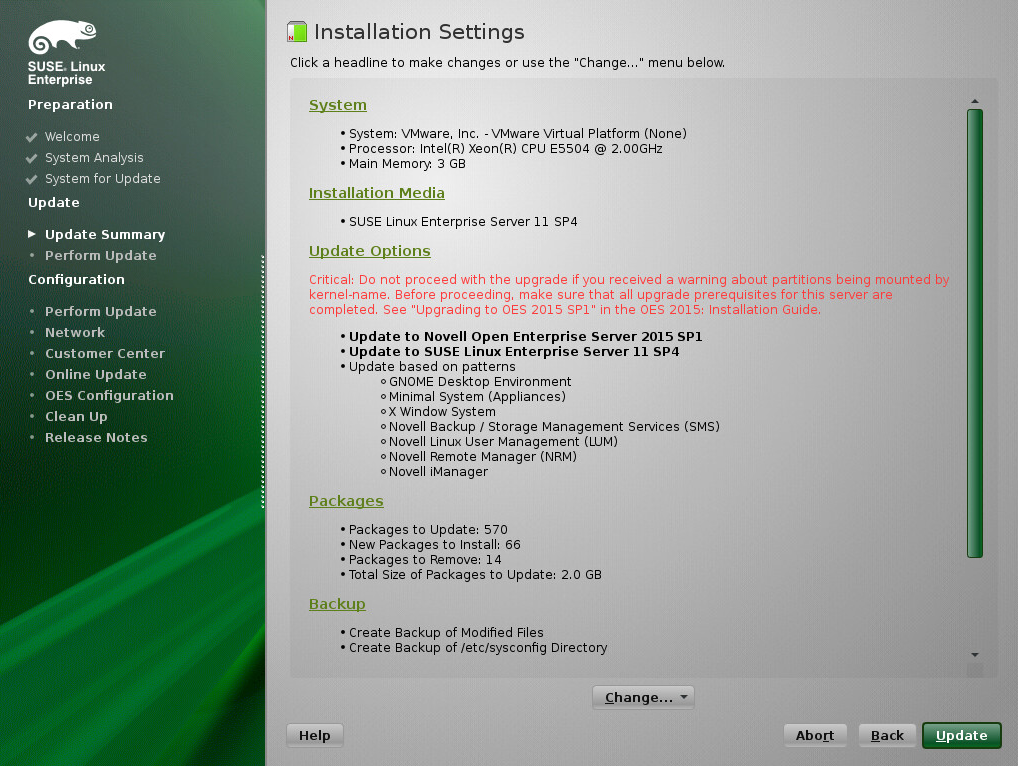
-
-
If you see package conflict errors (red text under the Packages link), refer to the OES 2015 SP1: Readme for resolution instructions.
-
Continue with Accepting the Installation Settings.
5.4.7 Accepting the Installation Settings
-
Review the final Installation Settings page to ensure that you have all the Installation settings you desire. Ensure that the page shows all the OES Services that you want to update and install.
-
After you have changed all the installation settings as desired, click Accept.
-
In the Confirm Update dialog box, click Start Update.
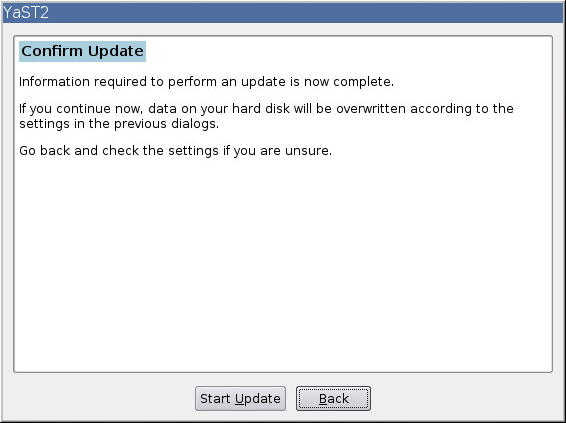
The base installation settings are applied and the packages are installed.
-
While the server is updating the files, do one of the following:
-
For installations using a network installation source, remove the boot DVD (SUSE Linux Enterprise Server 11 SP3 DVD1) from the DVD drive.
-
For installations using a DVD installation source, leave the DVD in the DVD drive. When the installation process prompts you for each DVD at the appropriate time, insert the DVD. The progress status at the bottom of the screen indicates which DVD will be prompted for next.
-
-
After the server reboots, continue with Specifying Configuration Information.
5.4.8 Specifying Configuration Information
When the server reboots, you are required to complete the following configuration information:
Testing the Connection to the Internet
On the Test Internet Connection page:
-
Select Yes, Test Connection to the Internet, then click Next.
-
Obtaining the latest SUSE release notes might fail at this point. If it does, view the log to verify that the network configuration is correct, then click Next.
-
If the network configuration is not correct, click Back > Back and fix your network configuration. See Network Interface. The most common problem is that an invalid DNS server is specified.
or
Skip this test by clicking No, Skip This Test, then continue with Step 4.
IMPORTANT:Most OES services configurations require a connection to the Internet.
Skipping this test also skips downloading release notes, configuring the Novell Customer Center, and updating online.
-
If you skipped the customer center test, continue with Upgrading eDirectory. Otherwise, continue with Specifying Novell Customer Center Configuration Settings.
Specifying Novell Customer Center Configuration Settings
To receive support and updates for your OES 2015 SP1 server, you need to register it in the Novell Customer Center. When the Novell Customer Center Configuration page is displayed, you have three options:
Updating a Registered Server (Recommended)
-
If you have already registered your OES 2015 SP1 server and you want to download the available patches, leave Configure Now (Recommended) selected, then click Next.
YaST contacts the server (which might take a few minutes) and then downloads the available patches.
-
Go to Step 8.
Registering the Server Later / Skipping a Registered Server Update
-
Click Configure Later.
-
Continue with Upgrading eDirectory.
Registering the Server During the Upgrade
-
On the Novell Customer Center Configuration configuration page, select all of the following options, then click Next.
Option
What it Does
Configure Now
Proceeds with registering this server and the SLES 11 SP4 and OES product in the Novell Customer Center.
Hardware Profile
Sends information to the Novell Customer Center about the hardware that you are installing SLES 11 SP4 and OES 2015 SP1 on.
Optional Information
Sends optional information to the Novell Customer Center for your registration. For this release, this option doesn’t send any additional information.
Registration Code
Makes the registration with activation codes mandatory.
Regularly Synchronize with the Customer Center
Keeps the installation sources for this server valid. It does not remove any installation sources that were manually added.
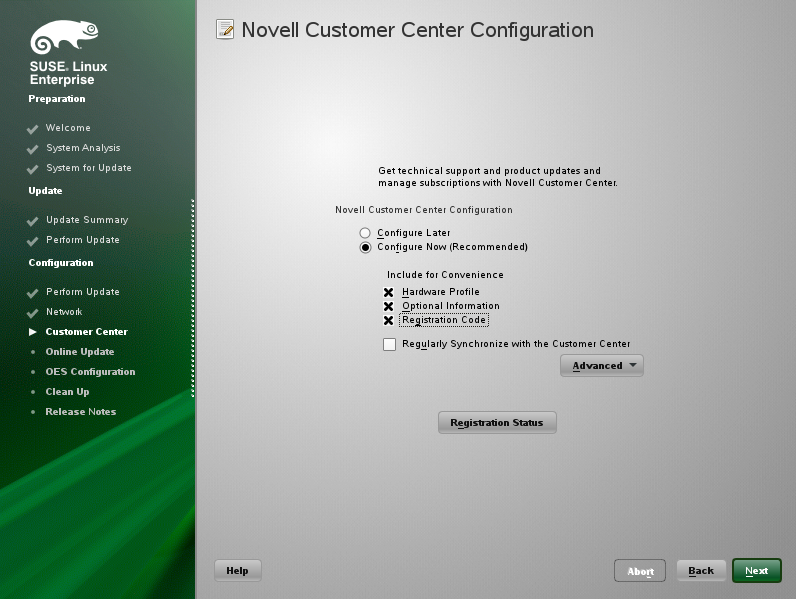
-
After you click Next, the following message is displayed. Wait until this message disappears and the Manual Interaction Required page displays.

-
On the Manual Interaction Required page, note the information that you will be required to specify, then click Continue.
-
On the Novell Customer Center Registration page, specify the required information in the following fields:
-
Email Address: The email address for your Novell Login account.
-
Confirm Email Address: The same email address for your Novell Login account
-
Activation Code for SLES Components (optional): Specify your purchased or 60-day evaluation registration code for the SLES 11 SP3 product.
If you don’t specify a code, the server cannot receive any updates or patches.
-
Activation Code for OES Components (optional): Specify your purchased or 60-day evaluation registration code for the OES 2015 SP1 product.
If you don’t specify a code, the server cannot receive any updates or patches.
-
System Name or Description (optional): The hostname for the system is specified by default.
If you want to change this to a description, for the Novell Customer Center, specify a description to identify this server.
-
-
Click Submit.
-
When the message to complete the registration displays, click Continue.
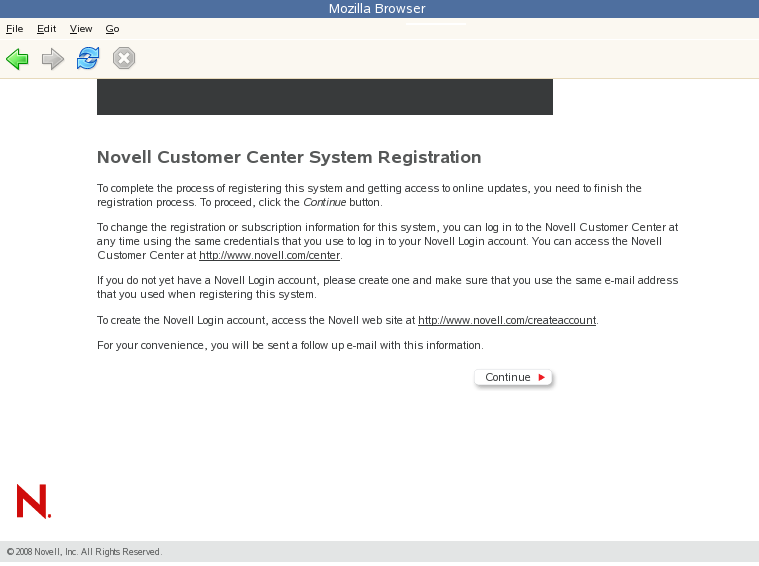
-
After you click Continue, the following message is displayed with the Manual Interaction Required page. Wait until this message disappears and the Novell Customer Center Configuration page displays with the message: Your configuration was successful.

-
When you see the message Your configuration was successful on the Novell Customer Center Configuration, click Ok.
-
Continue with Updating the Server Software.
Updating the Server Software During the Upgrade
If you have a successful connection to the Internet and have registered the server in the Novell Customer Center, the server displays the Online Update page. You can run the online update now or skip it and get updates later.
To skip getting updates during the upgrade:
-
On the Online Update page, click Skip Update then click Next.
-
Continue with Upgrading eDirectory.
To get updates during the upgrade:
-
On the Online Update page, click Run Update.
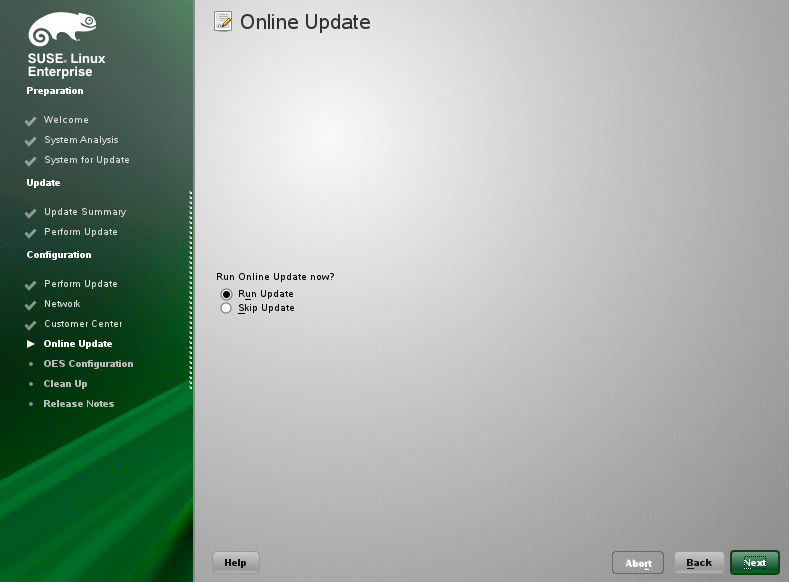
-
On the page that shows that updates are available, select the updates that you want to install, then click Accept.
The check marks that are shown in the summary column of the patches list are the patches that have already been installed on your system.
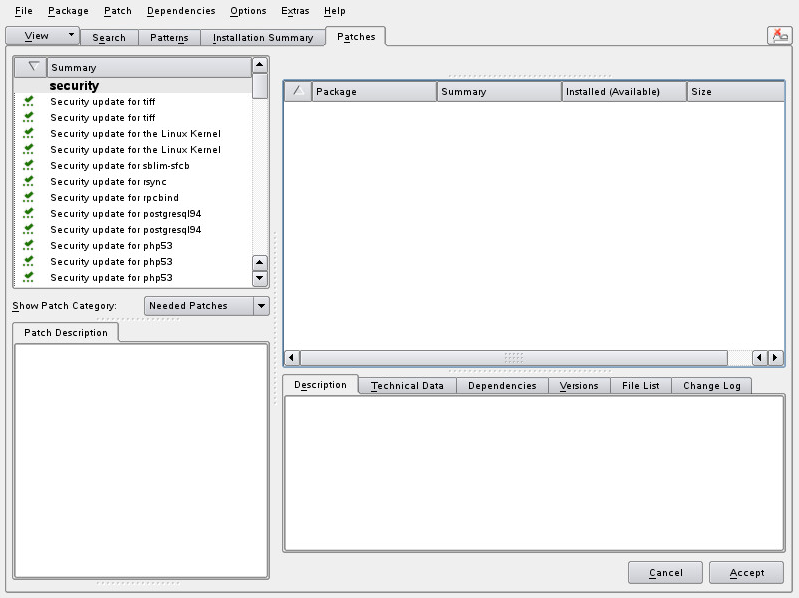
-
When you see the message, Installation finished on the Patch Download and Installation page, click Next.
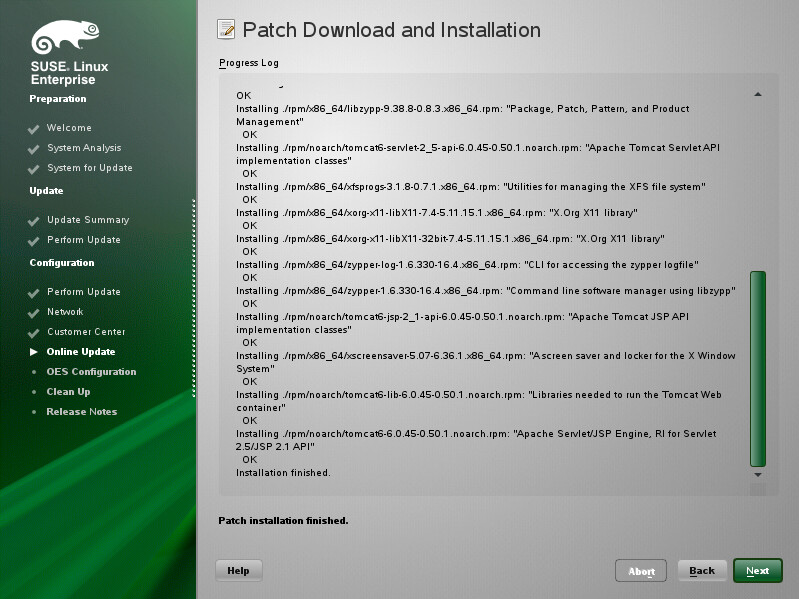
-
If the update makes changes to YaST, the following message displays. If so, click OK to restart YaST.
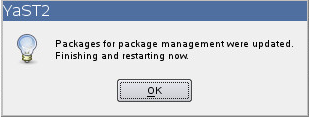
-
If the installation was interrupted, the following message might display. If so, click Yes to continue with the installation, then enter the root password.
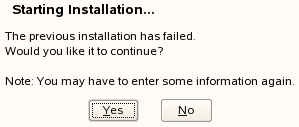
The online update displays again with additional updates. If a patch has changes to the kernel, you might want to deselect it and install it later after the installation is complete.
-
If you do install patches that have changes to the kernel, click OK.
-
After all the patches are installed, continue with Upgrading eDirectory.
Upgrading eDirectory
OES 2015 SP1 includes eDirectory 8.8.8.
-
When the following dialog box appears, click Upgrade.
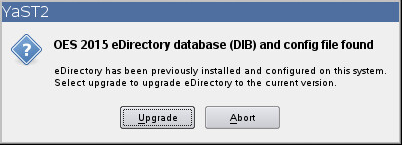
NOTE:
-
If you are upgrading from OES 2 SP3, this dialog will show that the OES 2.0 eDirectory database (DIB) and config file were found.
-
If you are upgrading from OES 11 SP2, this dialog will show that the OES 11 eDirectory database (DIB) and config file were found.
-
-
On the eDirectory Upgrade - Existing Server Information page, type the Admin password.
-
Click Next.
-
On the NetIQ Modular Authentication Service page, click Next.
-
Continue with Specifying LDAP Configuration Settings.
Specifying LDAP Configuration Settings
Many of the OES services require eDirectory. If eDirectory was not selected as a product to upgrade or install but other OES services that do require LDAP services were installed, the LDAP Configuration service displays so that you can complete the required information.
-
In the eDirectory Tree Name field, specify the name for the existing eDirectory tree that you are installing this server into.
-
In the Admin Name and Context field, specify the name and context for user Admin on the existing tree.
-
In the Admin Password Name field, specify a password for user Admin on the existing tree.
-
Add the LDAP servers that you want the services on this server to use. The servers that you add should hold the master or a read/write replica of eDirectory. Do the following for each server you want to add:
-
When all the LDAP servers that you want to specify are listed, click Next.
-
Continue with Configuring Novell Open Enterprise Server Services.
Configuring Novell Open Enterprise Server Services
After you complete the LDAP configuration or eDirectory configuration, the Novell Open Enterprise Server Configuration summary page is displayed, showing all the OES components you updated and installed and their configuration settings.
-
Review the setting for each component and click the component heading to change any settings.
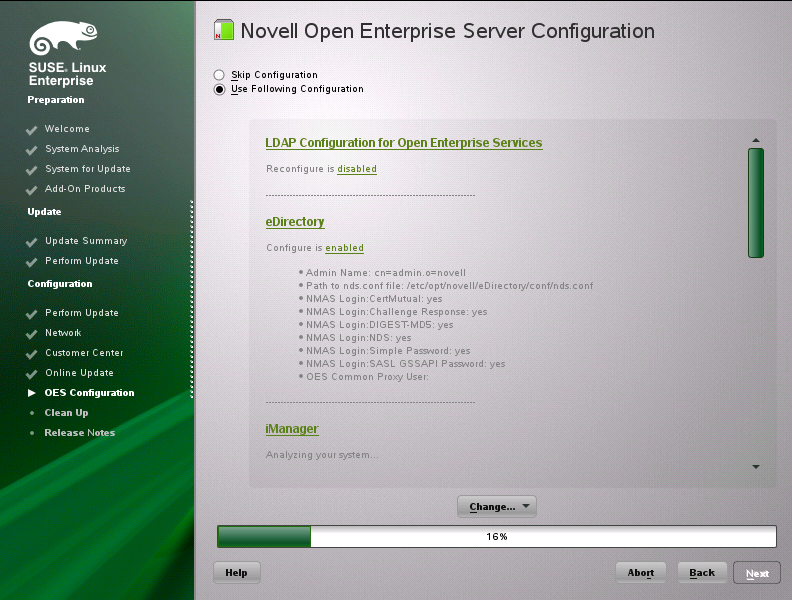
When you specify the configuration information for OES services, see the information in Configuration Guidelines for OES Services, or click a link below:
-
When you are satisfied with the settings for each component, click Next.
-
When you confirm the OES component configurations, you might receive the following error:
The proposal contains an error that must be resolved before continuing.
If this error is displayed, check the summary list of configured products for any messages immediately below each product heading. These messages indicate products or services that need to be configured. If you are running the YaST graphical interface, the messages are red text. If you are using the YaST text-based interface, they are not red.
For example, if you selected Linux User Management in connection with other OES products or services, you might see a message similar to the following:
Linux User Management needs to be configured before you can continue or disable the configuration.
If you see a message like this, do the following:
-
On the summary page, click the heading for the component.
-
Supply the missing information in each configuration page.
When you specify the configuration information for OES services during the upgrade, see the information in Configuration Guidelines for OES Services.
When you have finished the configuration of that component, you are returned to the Novell Open Enterprise Server Configuration summary page.
-
If you want to skip the configuration of a specific component and configure it later, click Enabled in the Configuration is enabled status to change the status to Configuration is disabled.
If you change the status to Configuration is disabled, you must configure the OES components after the installation is complete. See Installing or Configuring OES 2015 SP1 on an Existing Server.
-
-
After resolving all product configuration problems, click Next to proceed with the configuration of all services and installation of iManager plug-ins.
-
When the Readme page displays, click Next and continue with Section 5.4.9, Finishing the Upgrade.
5.4.9 Finishing the Upgrade
After a successful configuration, YaST shows the Installation Completed page.
-
Deselect Clone This System for AutoYaST. Cloning is selected by default.
This increases the speed of finishing the installation update.
AutoYaST is a system for automatically installing one or more SUSE Linux Enterprise systems without user intervention. Although you can create a profile from a system that has been upgraded, it does not work to upgrade a similar system.
-
Finish the upgrade by clicking Finish on the Installation Completed page.
